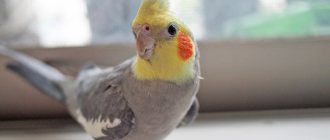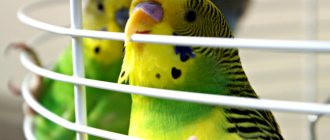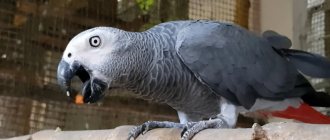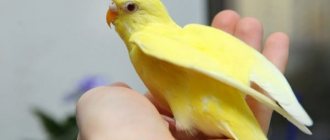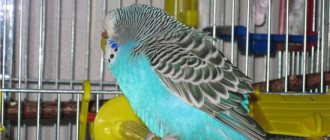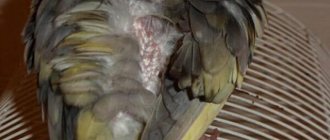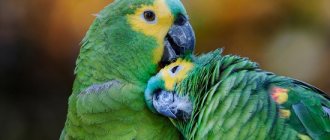Parrots are unique creatures, unlike any other living creature. Their diversity is amazing. Each species is beautiful in its own way. There are more and more holders, because these birds attract not only their appearance, but also their behavior. Those who are a little more interested in them than ordinary people often wonder: “Where does a parrot have ears, do they have them, and how does its hearing aid work?”
These birds definitely have hearing and even very good hearing, otherwise how could they communicate with each other and repeat the sounds of nature? Let's consider the hearing aid in a budgerigar, because... this type is the most common.
Location
The ears of the wavy are located on the sides of the head. You can’t just notice them, but in chicks they are noticeable because... the chick does not have the same feather cover as an adult. Ear search algorithm:
- The location of the ear is slightly lower and to the right of the eye.
- Feathers rise at this point.
The ear looks like a small round hole. There are feather hemispheres around it, which allow you to adjust your hearing depending on the time of day and the environment. The parrot can adjust these hemispheres.
At night the feathers press tightly together, and during the day they move apart again.
What do the ears look like and where are they located?
Unlike human ears, parrot ears do not have an outer shell. The hearing organs are paired and hidden under the plumage on the head. These are small round or oval holes that are located just below the eyes, closer to the back of the head. The entrances are covered with feather hemispheres. This structure is explained by the peculiarities of the life of birds: it is necessary so that during flight the body shape is streamlined. Additionally, the feather cover protects the hearing organs from wind and rain.
The parrot can regulate the volume of the sound itself: while listening, it raises its feathers, thus gaining access to its ear canals. If the animal is disturbed, it shakes and the scalp tightens. The folds around the holes form a funnel. The avian hearing aid picks up waves of the appropriate frequency depending on the density of the feathers around the ear openings. During sleep, feathers press closer to the skin and muffle sounds.
The openings of the ear canal are small, slightly larger than the nostrils. This applies to all breeds of parrots: not only gentle wolves, but also large cockatoos, mackerels and Amazons. For example, the cockatiel's ear cavity is hidden by orange spots on its cheeks.
Attention! Only the chicks' ears are visible to the naked eye: newly hatched chicks are not covered with feathers. The auditory openings, surrounded by folds, are clearly visible on the reddened skin.
Hearing
The auditory organ of budgerigars has amazing hearing characteristics. The bird is capable of detecting sound frequencies over a wide range. She will be able to catch even the quietest sounds with ease. Such abilities would be useful in the wild, where she needs to hear her relatives and predators.
The wavy can hear the rustling of leaves or grass, knocking, even breathing.
At home, such hearing is in no way in demand, but it will not be difficult for a parrot to hear its owner climbing the stairs. As parrots age, their hearing will decrease slightly. After 12-15 years of life, a decrease in hearing by 10-15% is observed. Like other living organisms, parrots' hearing can decline more quickly due to poor genetics or a noisy environment. In this case, partial hearing loss will be observed 2-3 years earlier.
How do they hear
The anatomy of birds is designed in such a way as to help them adapt to their environment, find food for themselves, and quickly respond to danger. Therefore, parrots are able to hear very quiet and distant sounds, which allows them to survive in the wild, which is often hostile for such small creatures.
Thanks to their ability to perceive sounds in the range of 120 Hz-15 kHz, many parrots can accurately reproduce a variety of sounds, words and phrases, songs, and even the intonation and timbre of their owners' voices.
Parrots' ears are also a means of communication. Birds make sounds in case of danger or in the process of courting a partner during the mating season. Having discovered feeding grounds somewhere, they notify their relatives in the flock about this with special sounds.
The auditory opening of a macaw parrot
Near the ears there are folds of skin on which feathers grow, acting as “locators”. Parrots regulate the volume of sounds by moving these folds. When a pet is frightened or alarmed, it begins to ruffle, the parotid feathers rise, opening the auditory tubes.
Structure of the hearing aid
A parrot's ears are not like animal ears. They do not have an external ear. Instead, she fanned feathers. Fans create a hollow air space above the ear canal. On the inside of the ear the frequency of feathers is greater. This is necessary to capture sounds. Together with the folds of the skin, feathers create space for capturing sounds. This structure is a bit like the outer ear of animals, but due to the need to fly, this structure is more advantageous, because allows you to overcome air currents.
The feathers around the ear serve both a protective and primary catching function. The wavy can lift the feathers, thereby increasing the area for catching sounds, and press the feathers tightly. In the first case, the parrot is able to hear any quiet sounds. This usually occurs while the pet is awake, when the pet needs to evaluate its surroundings. In the second case, the parrot reduces the number of frequencies picked up in a certain range.
For example, during sleep or rest, it eliminates the penetration of sharp sounds.
The middle ear is a tube of ligaments and muscle tissue. Inside it there is an eardrum, a bone in the form of a rod, and a membrane. Vibrations from the membrane are removed using the bone. Vibrations go to the membrane. Due to the vibrations, the fluid vibrates, impulses from which enter the brain. This is how sounds are recognized.
The hearing aid includes the vestibular apparatus, which is located in the inner ear. With natural irritation of sensitive hairs, signals come from receptors responsible for balance. These impulses travel along the vestibular nerve to the brain.
Thanks to vision, hearing, muscle and skin receptors, the parrot maintains balance.
Structural features
Unlike mammals, which have ear ears, parrots only have a middle and inner ear. The role of the upper ear is the handle, with the front, fluffy like a fan, forming the antheid, and the back, thicker and thicker, together with the empty folds forming the walls, dexterous sounds.
The middle ear is a jam filled with air. This consists of:
There are no other bones in the hearing. Thanks to its mobility, this single headache removes the vibration of the drum membrane. As a result of these vibrations, the inner ear begins to vibrate. A special liquid in its interior also begins to vibrate, and the impulses are transferred to the brain, which leads to the interpretation of sounds.
The inner ear is very complex, with labyrinths responsible for spatial orientation and balance. The receptors of these labyrinths transmit information to the brain about the distance to objects, flight altitude, the position of the bird in space, and much more.
The structure of parrots' ears is similar to the hearing organs of reptiles. They are completely different from human devices. In the UK, however, a famous man named Ted Richards, who had his ears removed to look like his pets, earned him the nickname "Parrot Man" in the media.
But birds hear much better than us. This ability has saved their lives more than once in the wild, and at home it helps them perfectly reproduce sounds and human speech.
See where your cockatiel's ears are located in this video:
Diseases
Regarding ear diseases, the veterinarian specialist says that there are few of them. Ear problems are often associated with other pathologies or periodic changes in the parrot's environment. If the bird is in a draft or in a room where the temperature is lower than normal, then the ears may blow out. Signs include the appearance of pus or swelling around the ear. Pus will form on the feathers in this area or liquid leaks will be visible.
Treatment is treatment with miramistin or tetracycline ointment in places where pus accumulates.
Sometimes sparse feathering can be replaced around the ear. This sign does not always indicate ear problems. It is possible that the parrot has started molting. To be sure the bird is in a healthy state, you should contact a veterinarian.
Also, you should not often make noise in the room where the bird lives. Budgerigars have very sensitive hearing, and loud noise can damage it.
Do parrots have ears?
Probably every bird lover who enjoys watching his pet once has a question: do parrots have ears, and how do they hear sounds?
Hearing devices in birds are invisible to our eyes, they are hidden by feathers, but parrots have them. Thanks to them, the birds not only hear well, but also have excellent spatial orientation.
The vestibular apparatus of birds is located in the hearing organs; if problems arise with them, they will not be able to fly or even just sit on a perch.
Data
- Budgerigars can be taught to count;
- They are divided into right-handers and left-handers. That is, a parrot may have a preference for grabbing food with a certain paw;
- Able to sleep all day;
- They can turn their head half a turn;
- They hear in the range from 400 to 20,000 Hz;
- They learn well by imitating sounds;
- Adult parrots give their chicks “names” with a certain sound;
- See the world in color.
Previous
Useful Perches and perches for parrots
Next
Useful Lamps for all types of parrots and the right choice
Parrot skeleton
| 1 - incisal bone; 2 - nasal opening; 3 - nasal bone; 4 - lacrimal bone; 5 - orbit; 6 - dentary bone; 7 - palatine bone; 8 - quadratozygomatic bone; 9 - pterygoid bone; 10-articular bone; 11 - square bone; 12 - tympanic bone; 13 - atlas; 14 - cervical vertebrae; 15 - thoracic vertebrae; 16-blade; 17 - ilium; 18- caudal vertebrae; 19- pygostyle; 20- ischium; 21 - pubic bone; 22 - sciatic foramen; 23 - locked hole; | 24 - femur; 25 - kneecap; 26, 27 - fibula and tibia, respectively; 28 - metatarsus; 29 - first metatarsal bone; 30 - first finger; 31, 32, 33 - respectively, the second, third and fourth fingers; 34 - sternum crest (keel); 35 - sternum; 36, 37,38 - respectively, middle, lateral and costal processes of the sternum; 39, 40 - respectively, the sternal and vertebral sections of the ribs; 41 - uncinate process; 42 - collarbone; 43 - caracoid; 44 - humerus; 45, 46 - radius and ulna, respectively; 47, 48 - carpal and ulna bones, respectively; 49-52 - fingers; 53, 54 - respectively, the mandible and mandible. |
Liked? Share with friends on social networks:
| Tweet |
Hearing diseases
If you notice that dirty, matted or damp feathers have appeared in the area where the parrots' ears are located, you should immediately show the bird to a doctor. You should also be wary of the fact that your pet is constantly scratching its head.
If the bird is provided with good conditions, and the owner treats it with love and care, there is no need to worry about health problems. Parrots have a fairly strong immune system, and there are practically no specific diseases. Ear problems usually occur when water enters the eustachian tube. This should be avoided at all costs: if your pet loves water treatments, carefully ensure that the place where the parrot’s ears are not immersed in water or gets wet at all.
Sometimes birds can damage their ears in fights or while playing. In such cases, it is also worth consulting a veterinarian.
Where are the hearing organs located?
You should not grab your pet and part the feathers on its head, trying to find the ears. You won't find them there. The outer ear of a parrot is completely different from that of a human, dog or cat. His little ear is a neat hole. The entrance to the auditory tube is small even in large species. The ear is protected from external influences by feathers.
The length of the feathers determines how clearly the ear is visible to the naked eye. For example, where the ears of budgerigars are located is not difficult to determine. Take a closer look at your pet: you will probably notice small dark spots on the sides of the head. But it is more difficult to determine where the ears of a cockatiel parrot are, because the feathers of this bird are slightly longer. And rosy cheeks can be confusing. The ears of these birds are located precisely in red spots and are hidden by feathers.
How to recognize a disease by appearance
A healthy parrot has smooth and even plumage, without bald spots. It is not ruffled, the feathers should be clean. Pay attention to the beak - normally it is smooth, without cracks, growths or delaminations. The bird's eyes should not be cloudy, red or watery.
The area around the bird's anus will also indicate ill health. If the feathers are glued together, there are remains of droppings, the anus is red, and irritation appears, then the bird needs help. If the process of defecation is difficult, the bird shakes its tail and strains, then there is a problem. In a healthy bird, the area near the anus is clean, without any remaining droppings.
The telltale signs of an unhealthy parrot are easy to recognize. He needs the help of a doctor if he:
- lost a lot of weight;
- breathing heavily;
- regurgitates undigested food, suffers from nausea;
- feels itchy;
- limps;
- sneezes, breathes through an open beak.
Your parrot needs to be seen urgently by a doctor if tumors appear on its body or if you notice discharge from its beak. Convulsions and seizures require immediate treatment.
